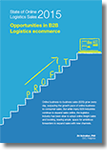There have been several great freight predictions for logistics in 2016.
We’re taking another approach, and are sharing some predictions that go against the grain.
From praising China’s “slowdown” to the benefits of overcapacity (for some), we’re kicking back against some industry givens.
1. China’s “slowdown” is good news
China’s annual economic growth hovered between 8%-15% for over two decades. With each year’s growth against a bigger base, the financial law of large numbers has caught up. That said, Goldman Sachs is predicting China’s economy to still grow by a whopping 6% this year.
Rising labor costs is pricing China out of some markets. Wisely, the government is therefore restructuring the economy to become driven more by internal consumption, instead of exports. To be sure, this assurance of medium term growth will change opportunities for international forwarders. But, this is surely a better scenario than a true medium-term China meltdown.
But with a 7% growth prediction for India, a strong US and the EU continuing its slow recovery, short term growth is good. And further trade development remains strong, with major infrastructure spends (e.g. a U.K. 50% increase in major rail and road projects, widening of both the Suez and Panama canals), and with freer trade (e.g. Iran’s sanction removal, agreement on the Pacific Trade Deal).
2. Overcapacity is good news (for some)
Ocean carriers are reeling. Overcapacity has plunged freight rates, profit and prompted mergers. Cutting capacity hasn’t worked. It’s a bad time to sell for scrap, so more ships are idle.
But that’s not necessarily all bad news for the larger players. Nils Andersen, Maersk CEO, was less sanguine when recently interviewed by the WSJ. But at a previous interview, Nils was more upbeat. The larger carriers have cooperated more closely through mergers and alliances to help defray the big capital costs of building new ships, and will recoup lower running costs. The smaller players, running at a loss for years, won’t be able to compete.
Wolf Street was even blunter in this assessment. The larger carriers are driving the price war. They are taking a bloody beating now, but it the spoils will eventually be more market share, and more market influence.
3. Margin Squeeze: Big Surprise Driver of Change
With lots of talk about mergers and technology, this may seem one of the more surprising freight predictions. The 2008-12 global recession, dampened demand, stoking TEU overcapacity, so plunging freight rates, and therefore forwarders’ margin. Since then, the glut of new superships has exacerbated overcapacity.
Not everything is moving in downward direction, though. Expenses are still going up, trapping many forwarders in a margin squeeze. The number one driver of forwarders in 2016 will be to reduce the margin squeeze, by branching into services with better profit margins, or finding short term or longer term cost savings.
4. Still More Splurges On Mergers
A key by-product of lower margins are M&As. Larger players can build from scratch or just buy what they need. In fact, 2015 was a record year for M&A spend.
M&As are not just driven by economies of scale, and of building market influence. There are several other telling reasons why. Like reach (e.g.Kuhne Nagel’s purchase of U.S. broker ReTrans). Or assets for hedging (e.g. XPO’s purchase of Con-way). Or moving into more lucrative services, like freight software (e.g. C.H. Robinson’s acquisition of Freightquote).
So with so many good reasons to buy, and on ongoing margin squeeze, it’s one of the easier freight predictions. 2016 will continue to be a busy year of consolidation.
5. Industry Shake-Up: Losers Pick Themselves
If margin squeeze is the biggest driver of change, cutting costs is also a tempting response. CH Robinson VP, Jason Luedtke, was recently interviewed by Talking Logistics. From the 7:30 minute mark Jason differentiates between sustainable cost savings (often through closer collaboration between shippers and forwarders), and the dangerous temptation to make opportunistic cost cuts.
All of the options to escape margin squeeze carry risks. But in a tight market, and where competition is actively searching for ongoing efficiency gains, those forwarders shedding labor resources now, passing up on the high-tech options for ongoing cost savings, are the ones least likely to be around in five to ten years time.
6. Freight Industry Is Finally Online
If margin squeeze is the biggest driver of change, then adopting new technology to unlock ongoing cost savings has become very appealing.
After an initial period of reticence, progressive forwarders are embracing the new technology. Kuehne+Nagel, recently revamped its technology to enable online booking for less-than-container load (LCL) shipping. Think again the previously mentioned CH Robinson purchase of Freightquote. Then there are the online forwarders (like iContainers), ancillary startups (like Haven which provide instant ocean container slot booking), or an Amazon air cargo operation. The company already makes deliveries with thousands of Amazon-branded truck trailers and operates over 165 fulfillment centers around the world. And Amazon China just received a NVOCC license for operating in the U.S.
Although Amazon is focussing on bringing inbound shipping costs and fulfilment in-house, reducing costs by automation, the company has a history of converting optimised processes into platforms for sale. There is still plenty of time before this might happen for freight movements, but forwarders should take note.
8. Smart Shippers Are Calling The Shots
Expect more shippers to be collaborating with other shippers to reduce freight spend, and crunching big data to benchmark freight rates, and make the right in-house/outsourcing decisions.
Low technology and inefficient operations may not have held forwarders back over the past 25 years, but it sure annoyed its customers, the shippers. Fancy spending 91 hours to get a spot quote? Or never really knowing whether your quote or negotiated rate was competitive?
Today a lot more information is available to shippers, starting with a plethora of digital online logistics resources. There’s online rate comparison sites, CargoSmart’s Big Schedules (live ocean schedules) and rate information like the Cass Freight Index and the Shanghai Containerized Freight Index.
9. We Start Thinking Of Freight As Big Parcels
Parcel delivery has been re-invented by technology. Even now, same day e-commerce delivery is transforming distribution infrastructure.
Shippers are now expecting service from forwarders commensurate with parcel delivery. Take for example, freight tracking technology. Accurate event information and exception notification started relatively recently as an expensive value-add that few forwarders could offer and few shippers could afford. Today even small shippers won’t ship unless they can check the status of their shipment.
It may seem the most outlandish of these freight predictions, but for B2B e-commerce, expect mounting buyers demands to be finally satisfied by the new technologies.
10. The Industry Has It’s Head In The Clouds
One of the safer freight predictions. YouTube videos of drones, robotics, augmented reality in action are exciting. But most of this is happening at other points along the supply chain.
More and more forwarders correctly have their heads in the Cloud, with tech products giving forwarders the automation payoffs they need.
About the Author
John Edmonds runs research at Freightos, a logistics startup bringing international freight online for forwarders, shippers and oversized e-commerce, with instant freight quotes, freight rate management and big data analysis.
Related White Papers
State of Online Freight Sales
While many business-to-business sales industries continue to expand sales online, the logistics industry has been slow to adopt online freight sales and booking, leaving ample space for ambitious forwarders to expand sales with new channels. Download Now
What Shippers Want
A roadmap for online freight services: Following suit from other industries, forward thinkers in the industry are already adopting online freight quotes and sales as a key differentiator, gaining an important competitive advantage in a crowded market space. Download Now
Article topics
Email Sign Up



















